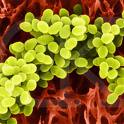There could be a connection between anorexia and cannabinoid receptors,
according to a new research report by Cindy Casteels, a Post-Doctoral Researcher of the Division of Nuclear Medicine and
Molecular Imaging at Katholieke Universiteit Leuven, located in Leuven,
Belgium. Cindy's PhD thesis was in Molecular imaging of the type 1 cannabinoid
receptor in movement disorders, under supervision of Prof. K Van Laere.
Anorexia nervosa is an eating disorder characterized by food restriction and irrational
fear of gaining weight, as well as a distorted body self-perception. Cindy's focus on anorexia is due to the significant impact that the
disease has on the lives of many people.
As well as psychological factors, some medics also think that there is a
physiological consequence for anorexia. Specifically, there could be a
connection between a dysfunctional endocannabinoid system (ECS) and eating
disorders. The ECS is a
term given to a group of lipids and receptors that are involved in a variety of
physiological processes. Cindy explains the significance of the ECS: "The
endocannabinoid system (ECS), a major neurotransmission system, is involved in
numerous physiological processes often related to homeostatic balance but also
in neuro-protection, motor behavior, memory regulation, addiction and
cognition. It consists of a family of naturally occurring lipids, the
endocannabinoids, of degradation proteins and of cannabinoid receptors."
These receptors are found in the brain, organs, connective tissues,
glands, and immune cells, and they are produced naturally by the body. One
function of the ECS Cindy explains, is "as an important component in many
different homeostatic processes in living organisms, including food intake,
energy metabolism and reward processing. It is therefore a potentially
interesting therapeutic target in eating disorders such as anorexia and bulimia
nervosa, but also in obesity."
Specifically, in relation to body health, the ECS helps to control the
way the body reacts to certain foods and the feeling that people get from
eating food (what are termed the ‘hedonic aspects’ of eating). One type of
receptor, found as part of the ECS, called CB1, is part of the brain region
that control food intake, reward and energy balance.
Another function of the ECS is mediate the psychoactive effects of
marijuana. This is because marihuana contains phytocannabinoids. These are
plant substances that stimulate cannabinoid receptors, such as the
Delta-9-tetrahydrocannabinol (THC), which is the most psychoactive of the
marijuana cannabinoids. Phytocannabinoids help to stimulate the endocannabinoid
system, and also influence the production of receptors. The ECS receptor that
is stimulated is CB1, the same receptor that is linked to food intake and food
enjoyment.
Cindy surmises: "Regarding food intake, animal studies showed that
CB1 knockout mice are leaner than control mice due to reduced food intake, and
the same mice are resistant to diet-induced obesity when subjected to a highly
caloric diet without their energy uptake being reduced."
To explore this further Cindy Casteel's research team undertook studies
on rats (rodents are good candidates for studying eating disorders). In the study, one
group of rats were bred to be anorexic and were placed in cages with running
wheel; another group were also bred to be anorexic but they were not given a
running wheel; a third group were fed a normal diet and were given a running
wheel and a final 'control group' were fed normally but they did not have a
wheel to exercise on. These various groups were designed to mimic all variables
of anorexia nervosa in rats.
For the simulation of anorexia, animals are food restricted (only
allowed access to limited amounts of food for short periods) and are given
unrestricted access to a running wheel. This is designed to reproduce both the behavioral
and neurophysiological conditions of anorexia nervosa. To model anorexia Cindy
explains that "the target weight was ~85% of initial weight."
The investigation into the effect of cannabinoids on the rats was shown
by an advanced nuclear imaging technique called positron emission tomography (PET).
The imaging was designed to look at cannabinoid receptors inside the rats. The
researchers scanned the rats for CB1 receptor availability during the anoreix
nervosa condition, when they gained weight again.
The study's results have been published in the European Journal of Nuclear Medicine and
Molecular Imaging.
According to Cindy: "Future studies simultaneously measuring brain
endocannabinoid levels and CB1 receptor binding are needed to further clarify
this issue. Of special interest, we have observed a similar finding of a
widespread increase in female anorectic patients, suggesting validity of our
animal model to mimic human CB1 receptor alterations in anorexia nervosa."



